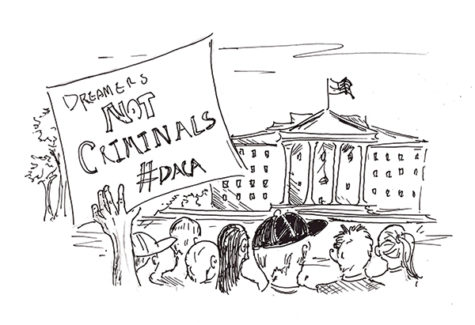Their dream, America’s reality
Deferred Action for Childhood Arrivals (DACA) is a program that has given protection against deportation to over 800,000+ undocumented immigrants. It specifically protects children coming into the US, and continues to protect them from deportation throughout their adult lives. DACA recipients are all over the US, including the Palo Alto Unified School District. Due to the recent political controversy, C Magazine hopes to inform readers about how this affects students everyday lives.

Most American citizens do not think twice before taking their driver’s test, filling out a job application or writing their college essays. However, for over 11.4 million people living in the United States, including some Palo Alto High School students, doing these seemingly mundane tasks do not come as such a luxury.
America is viewed by many as the land of opportunity; millions of people immigrate to the United States in search of success they otherwise wouldn’t be able to attain in their country of origin. However, immigration has been a controversial topic in American history since its founding. In the mid 1800s, Irish immigrants were immediately met with discrimination upon arriving to the US due to their Catholic beliefs. Furthermore, in 1882, the government banned the immigration of Chinese laborers to the U.S. through the Chinese Exclusion Act. Most recently, in the last presidential election cycle, the Mexican border and illegal immigration were popular debate topics.
In California alone, there are 220,000 undocumented immigrants. The ability to attend school or purchase a home are just a few of the privileges that are not as accessible for undocumented immigrants as they are for those born in the US. This changed in 2012 when President Barack Obama issued an executive order to enact a bill called the Deferred Action for Childhood Arrivals (DACA), which deferred 800,000+ illegal immigrants from being deported. The executive order’s goal is to protect undocumented immigrants who were children when their parents brought them to this country. Now, the future of DACA is threatened by a six month expiration date that the Trump Administration put into place.
The topic of undocumented immigrants was consistently debated in Congress before and throughout Obama’s presidency, but yielded unproductive results. President Obama bypassed their approval in June 2012 through an executive order to enact DACA. The Republican response to his order was negative as many people believed that his circumvention of Congress’ vote and implementation the bill was an unconstitutional abuse of executive power. Although Congress disagreed with President Obama’s use of executive power, DACA was rolled out.
Essentially, DACA is a two-year, renewable permit that shields recipients from being deported; the goal is to ensure the protection of young, undocumented students, referred to as Dreamers, and allow them to attend school or work legally in the US if they meet basic requirements.Dreamers are named after a 2001 bill called The DREAM Act, or Development, Relief, and Education for Alien Minors Act, which was a multi-process legislative proposal that would allow for undocumented people brought into the US as children to first be granted “conditional residency.” Upon meeting additional requirements, Dreamers could be considered for permanent residency which would potentially grant them US citizenship.
The hope was that they would have the ability to create a better life for themselves in America without the constant fear of deportation. However, the DREAM Act failed to receive enough votes from Congress to pass. It has been reproposed multiple different times in both the House of Representatives and the Senate since its initial rejection, but continues to be unsuccessful.
Opposers to the bill cite it as possible incentive for more undocumented immigration into the US. This said, California created their own version of the DREAM Act to implement through the state government. The California DREAM Act was enacted in 2011, allowing undocumented immigrant students access to private school scholarships within the state. Since the DREAM Act never passed federally, President Obama also introduced the policy of DACA in 2012, which did contain many similar concepts to the DREAM Act.
As the discussions began to arise regarding the idea and implementation of DACA, political party tensions rose due to much of the Republican predisposed opposition to President Obama. However, no official action was carried out against the bill due to the Democratic Party maintaining the majority in the Senate. Many people, regardless of party, also agreed that these children were brought to America by their parents and should not be forced to live by the constant concern of their citizenship status; much of its opposition was instead targeted towards President Obama’s choice to use his executive privilege.
To further combat the barrier that undocumentation creates from having a normal life in the United States, Obama opened up a program to include the undocumented parents of children who are US citizens called Deferred Action for Parents of Americans or DAPA in 2014, which was projected to have protected around 4.5 million undocumented parents.
The introduction of DAPA received much more backlash than DACA.Some Americans believed that the undocumented parents who chose to immigrate to the US without documentation should not receive the same benefits as Dreamers protected by DACA, who were not involved in the decision to immigrate to the US. This controversial bill led to 26 states, spearheaded by Texas, to sue the Obama Administration in the trial United States vs. Texas. They claimed it was an overstep of his power, and therefore the program was never enacted.
The 2016 Republican presidential race, led by current President Trump, was full of opinions regarding immigration in America. President Trump won over many voters with his promises to implement strict immigration policies. After almost eight months in office and no removal of DACA, many Republicans became upset and 15 states threatened to sue the Trump Administration for not fulfilling promises of strict immigration reform. This led President Trump to set an end date on the DACA program, giving Congress six months to pass an alternative plan or DACA would be terminated.
Over the course of the five years DACA has been in place, over 800,000 people have gained confidence to apply for the protection it offers. In exchange for DACA’s protection, recipients supply the government with their personal information including names, addresses and fingerprints; they also have access to all of the documents received by recipients including driver’s licenses, workplaces and social security numbers.
When applicants first began providing their personal information, there was a guarantee of protection. Now, with the uncertainty of the future of DACA, Dreamers are apprehensive about their information being used against them in an effort to deport undocumented people registered under DACA.
Unless congress passes another bill before DACA’s expiration deadline is reached, no DACA permits will be renewed, subsequently revoking all drivers’ licenses, work permits and social security numbers Dreamers currently hold.
The end of DACA could have catastrophic implications for the young adults who have received its protection. Congress should be aware of these problems when deciding what policies to implement regarding the immigrants have lived in the US the majority of their lives and consider it their home.
Daca eligibility requirements:
1. Under the age of 31 as of June 15, 2012
2. First arrived to the us prior to their 16th birthday.
3. Resided continuously in the us from june 15th, 2012 to present
4. Physically in the us on june 15th, 2012
5. Came to the us without documentation before june 15th, 2012 or their status expires as of june 15th, 2012
6. In high school, have a high school diploma, or have been honorably discharged from the military or coast guard.
7. Not convicted of a felony, 3 misdemeanors or any significant misdemeanors

Eric, a Paly senior who has chosen to stay anonymous for this story, is one of many students directly affected by DACA. Eric, the youngest of four and the only one of his siblings protected by DACA, spent most of his childhood with his mother. As a young child, he recalled his family being split up a lot of the time because his father and two brothers would move back and forth from Mexico to the U.S.. Having experienced this all at such a young age, he can “only remember so much from those first five years of my life,” Eric said.
The constant movement back and forth between the two countries stopped around the time Eric turned five, when he and his family moved to America. Initially, they moved to Mountain View where Eric attended kindergarten through 5th grade at Monta Loma Elementary school and then moved onto Crittenden Middle School from 6th to 8th grade. The following summer, he moved to Palo Alto to attend Paly as an incoming freshman. DACA allowed Eric to create a new life for himself, and it was something that his father told him to take advantage of.
“It was a constant reminder from my father, that I should take advantage of the education and resources provided by the country and area we live in,” Eric said.
Being a part of DACA has affected Eric’s life as he was given the promise of safety as long as he abided by the program’s regulations. He has also been able to obtain a work permit, allowing him to work for the past year at a restaurant. With the election of President Trump, Eric is aware of the controversial issues surrounding DACA, but thought it was best to keep “a positive mindset.”
Even though he’s a member of many communities, Eric continues to feel like an outsider, not knowing where to fit in. Eric understands there are preconceived notions about different cultures and stereotypes people may have, but claims that people are going to believe whatever they want. His positive mindset allows him to proudly show off his Mexican heritage, and he notes that the political climate is just another obstacle that he will overcome.
With this pride comes confusion as he believes that being both Mexican and American means that he isn’t truly one or the other. “I don’t think I’d feel like I’d fully fit in if I went back to Mexico. I’ve been here for the majority of my life.” he said.
Being Mexican already classifies Eric as being a minority, but adding his citizenship status on top leads him to believe that he is “a minority within the minority group,” Eric said.
A smaller community that Eric is part of is at Paly. Even though he feels somewhat isolated, Eric mentions how supportive the Paly administration has been, and when the recent incidents with DACA occurred many of his teachers reached out to him.
Some politicians and citizens believe that immigrants should not have the same opportunities as U.S. citizens because of their undocumented status. Eric opposes this by stating that immigrants come to the U.S. to better the lives for themselves and families, not to impose any harm on anyone or anything.
The protection he received from DACA has allowed him to immerse himself in academics and not solely focus on his citizenship status. However, that assurance was all taken away with the election of Trump, due to his standing on illegal immigrants, as well as both the Senate and House majority now being Republican, who are generally associated with hardliners on immigration policies. Although Eric is doing his best to keep an open and positive mindset, it’s human nature to think about the daunting possibility.
“Sometimes you just kind of wander off and think, am I going to be sent back?” Eric said. Eric will not let these setbacks get in his way of what he hopes to accomplish in the future, and he is currently applying to colleges with hopes to continue to further his academic career.








